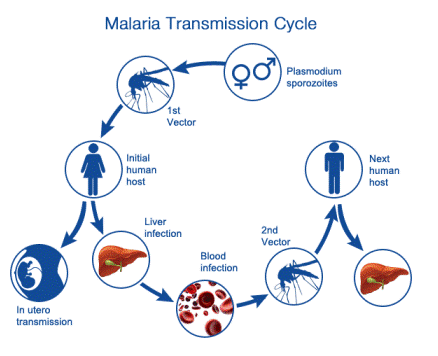Malaria











Malaria
Malaria: This disease is caused by protozoans of the genus Plasmodium (species: vivax, ovale, falciparum, and malaria). These parasites grow and multiply in the liver and the RBCs of man. They also grow in the gut of the female Anopheles mosquito, which is the vector. The protozoans enter our bloodstream when a female mosquito carrying them bites us.
Signs and Symptoms: Malaria is characterized by periodic attacks of shivering followed by high fever. Headache and muscular pains, anaemia and enlarged spleen are other symptoms.
Control: A person suffering from malaria is given quinine, a drug which has been in use since long. It is extracted from the bark of the cinchona tree. A substance called arteether extracted from another plant is also an antimalarial drug.
Prevention: The occurrence of malaria can be prevented in two ways. First, by breaking contact between Anopheles mosquitoes and human beings, and second, by not allowing the mosquitoes to breed. Contact can be broken by using mosquito nets, mosquito repellents, etc. And the breeding of mosquitoes can be prevented by eliminating breeding places and by killing the eggs, larvae and adults with the help of chemicals or biological agents. Common chemical methods of killing mosquitoes and their larvae have been spraying insecticides (e.g., DDT) in powder or liquid form or as fumes (fumigation), and spraying kerosene over stagnant water.

The _________________ places of mosquitoes should be destroyed around our house. | |||
| Right Option : A | |||
| View Explanation | |||
Infective stage of plasmodium vivax is called ___________________ | |||
| Right Option : C | |||
| View Explanation | |||
All the following are preventive measures of malaria except ______________ | |||
| Right Option : B | |||
| View Explanation |
Students / Parents Reviews [10]
My experience was very good with Abhyas academy. I am studying here from 6th class and I am satisfied by its results in my life. I improved a lot here ahead of school syllabus.

Ayan Ghosh
8thAbhyas is a complete education Institute. Here extreme care is taken by teacher with the help of regular exam. Extra classes also conducted by the institute, if the student is weak.

Om Umang
10thIt was a good experience with Abhyas Academy. I even faced problems in starting but slowly and steadily overcomed. Especially reasoning classes helped me a lot.

Cheshta
10thBeing a parent, I saw my daughter improvement in her studies by seeing a good result in all day to day compititive exam TMO, NSO, IEO etc and as well as studies. I have got a fruitful result from my daughter.

Prisha Gupta
8thAbhyas Methodology is very good. It is based on according to student and each child manages accordingly to its properly. Methodology has improved the abilities of students to shine them in future.

Manish Kumar
10thAbout Abhyas metholodology the teachers are very nice and hardworking toward students.The Centre Head Mrs Anu Sethi is also a brilliant teacher.Abhyas has taught me how to overcome problems and has always taken my doubts and suppoeted me.

Shreya Shrivastava
8thI have spent a wonderful time in Abhyas academy. It has made my reasoning more apt, English more stronger and Maths an interesting subject for me. It has given me a habbit of self studying

Yatharthi Sharma
10thA marvelous experience with Abhyas. I am glad to share that my ward has achieved more than enough at the Ambala ABHYAS centre. Years have passed on and more and more he has gained. May the centre flourish and develop day by day by the grace of God.

Archit Segal
7thMy experience with Abhyas academy is very good. I did not think that my every subject coming here will be so strong. The main thing is that the online tests had made me learn here more things.

Hiya Gupta
8thIt has a great methodology. Students here can get analysis to their test quickly.We can learn easily through PPTs and the testing methods are good. We know that where we have to practice
